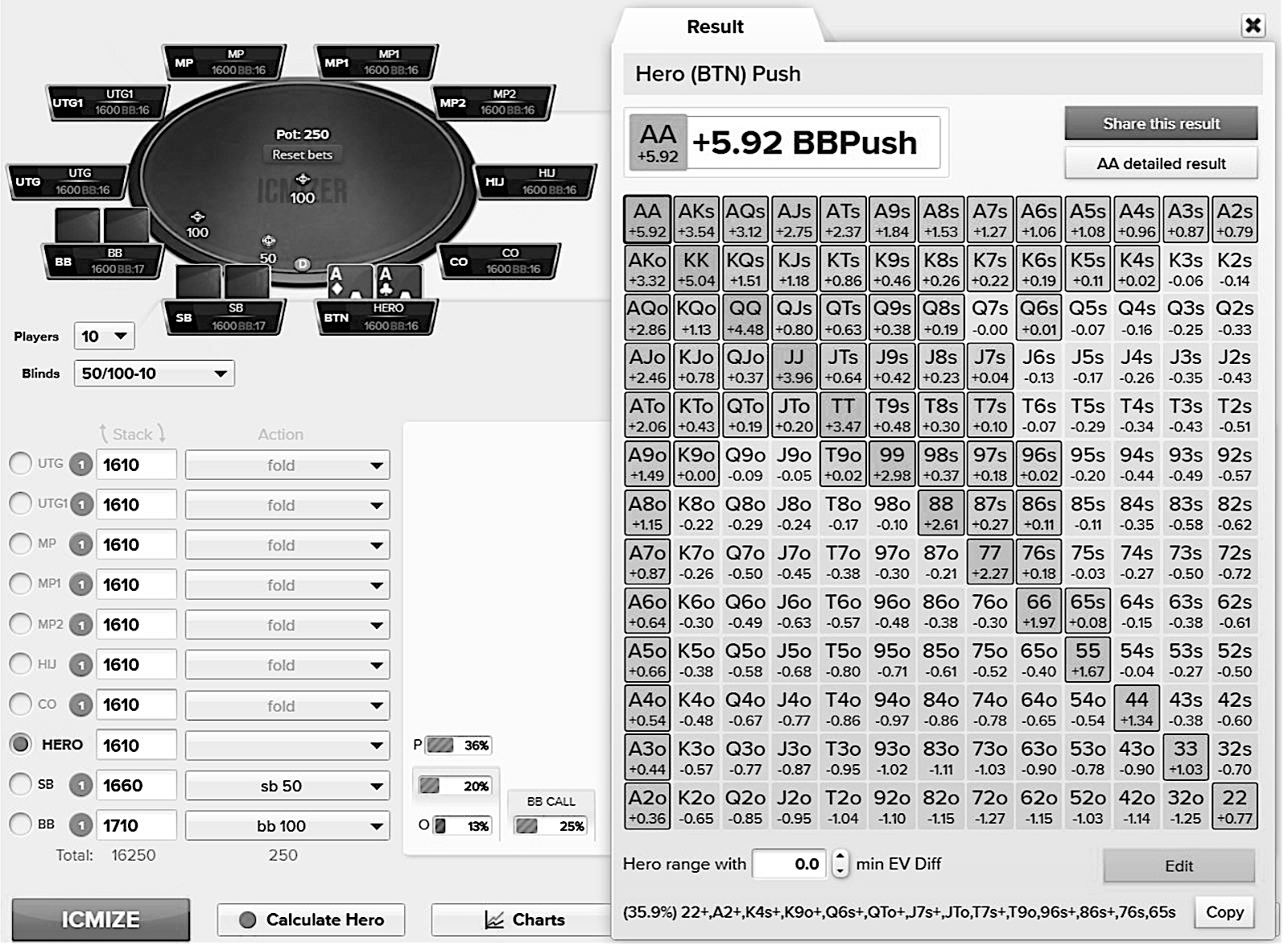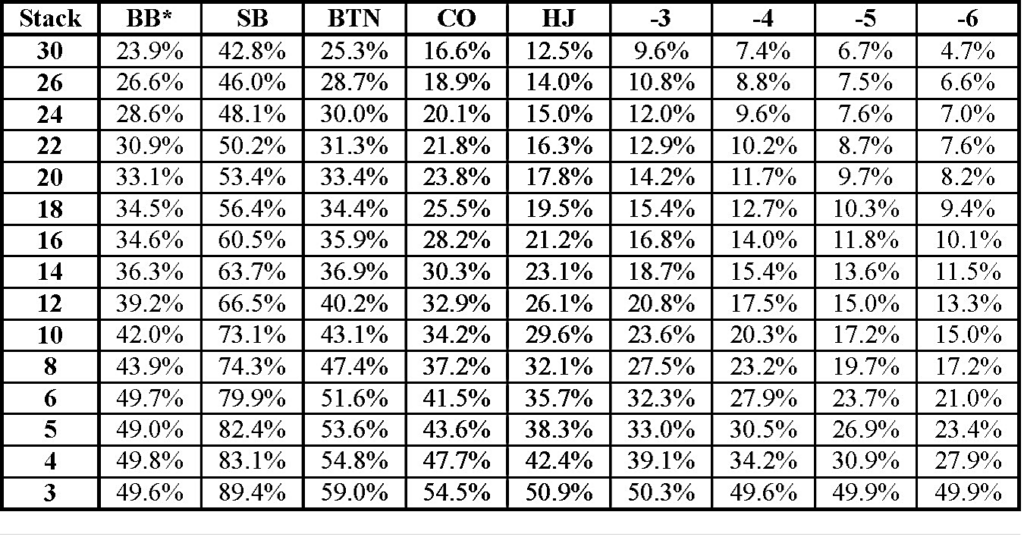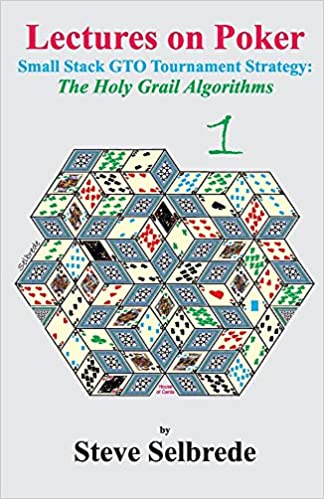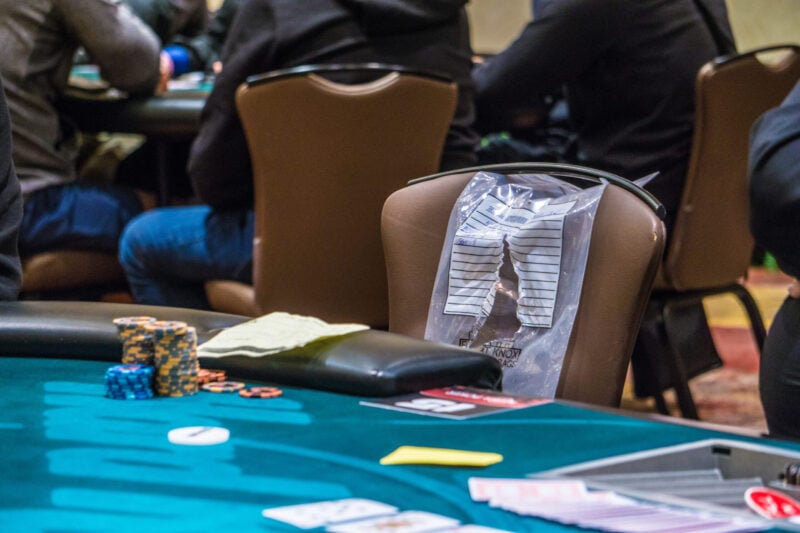“The rule is, jam tomorrow and jam yesterday, but never jam today.” Lewis Carroll
This is the first in a series of articles introducing my GTO Holy Grail Algorithms. These articles are based on my newest book, Lectures on Poker, Volume 1: Small Stack Tournament Strategy.
Game theory
Game theory is a very robust field of mathematics, but its real-world poker applications are usually difficult to apply.
Poker pundits often refer to a particular play as the obvious GTO (Game Theory Optimal) play; “Phil’s raise is the GTO play to make here.” But rarely do these decisions have anything to do with game theory. They might better be described as the “statistically optimum” or “mathematically correct” play, the one Mr. Pundit believes has the highest expected value for the hand.
“Game Theory Optimal” is actually a misleading term. GTO is not necessarily the most profitable play; it’s just the play that is unexploitable by our opponents. Consequently, we may not want to make the GTO play, even when we know what it is. Although our play would be unexploitable, we may be passing up a more profitable option; one which exploits our opponents’ errors. Our true goal should be to maximize our profitability, which usually means playing exploitatively. Nevertheless, it’s important to know the correct GTO play, especially when the stacks are short.
A simple model
Game theory is a mathematical theory of games, but it doesn’t cover every type of game. Game theory is only concerned with strategy games between at least two competitors, where each player’s strategy can be adjusted to adapt to his opponent’s strategy. It’s essentially a theory of optimized adjustment.
Consider Rock-Paper-Scissors, a simple game played between two players. Each player simultaneously forms one of three possible shapes with an outstretched hand: rock, paper, or scissors. Rock crushes scissors, scissors cuts paper, and paper covers rock.
RPS is an excellent game for illustrating some basic principles of game theory. Andy and Bob each bet $1 on the outcome of a large number of RPS games. Suppose Andy starts out by always flashing rock. (Andy’s a geologist.) Bob likes paper (he’s a journalist). So, in the beginning, Andy loses every time. But Andy wises up and switches to scissors; Now Andy wins every time. Eventually, Bob realizes that he needs to make each choice exactly 1/3 of the time in a random fashion.
Bob’s strategy is Game Theory Optimal. No matter what strategy Andy employs, Bob will break even in the long run. When Bob employs his GTO strategy, no strategy that Andy might employ can reduce Bob’s win rate. However, if Bob realizes that Andy prefers rock, Bob can deviate from his GTO strategy and choose paper more often. This would be an exploitive strategy.
Game theory in poker
RPS is a useful model for understanding the basic idea of game theory, but it doesn’t help us decide what to do in a poker game. In fact, some concepts we learn from RPS game theory don’t apply to poker situations at all. For example, when Bob plays GTO RPS, he’s guaranteed to break even, no matter how badly Andy plays. But a perfect GTO poker player will be profitable, not break-even, if his opponents are making mistakes.
There are also other considerations in poker. Bubbles, pay jumps, ICM, and chip utility can influence what our most profitable play is. Nevertheless, knowing what the GTO play is in a given situation is immensely valuable.
GTO solvers and shoving charts
My personal Holy Grail quest was to develop a GTO, open-shoving strategy for full-table, live-tournament situations with less than 30 BB effective stacks. This is a formidable goal since there are hundreds of situations to learn, and a major reason why only a small fraction of tournament players employ an accurate GTO strategy.
Our first step is to determine the GTO shoving ranges for a wide variety of situations. There are many free tools we can use for this, such as:
- Pre-configured tables (ConsciousPoker.com/push-fold-charts/) or simple applications (floattheturn.com/wp/tools/pushfold-app and snapshove.com). SnapShove is an especially useful way to explore how various parameters can influence our GTO ranges. None of these solutions is truly a GTO solver, however. They simply compile pre-computed answers in a look-up table.
- SimpleNash (simplepoker.com/en) is a true GTO solver and gloriously free. SimpleNash provides more detailed outputs over a wider range of initial conditions than the simpler applications. Its main drawback is the lack of any instruction manual.
- ICMIZER3 (https://www.icmpoker.com/) is a step up from SimpleNash. It is more full-featured with better documentation and a much better interface. Its downside is that it requires a monthly subscription fee. ICMIZER3 is powerful, easy to learn and the solver I use for my GTO calculations.
The first key variable to consider is the ante structure. The presence of antes determines how many chips we win when our open-shove is successful. Different ante structures produce different GTO charts. A conventional ante creates a different pot, depending on the tournament level and the number of players dealt in. I chose to use the Big Blind Ante structure for my baseline GTO strategy because it always produces the same 2.5 BB pot. We can then adjust our strategy based on the actual amount in the pot in our current situation.
The second key variable is our table position. Clearly, our GTO open-shoving range will be wider from the button than it is from UTG.
The third key variable is our effective stack size. It is the smaller stack size that matters in a heads-up battle. But this gets more complex with additional players. I will dodge this issue here and assume, for now, that Hero’s stack is the same as the effective stack. (This is discussed in detail in my book.)
Figure 1 shows the open-shoving range when we are on the button with 16 BB effective stacks and the equivalent of a BBA. This range includes 35.9% of all starting combos, as indicated in the bottom-right of the figure. Note that the chart indicates the EV of each combo for open-shoving. You must click on the “Edit” button to display the actual 35.9% GTO open-shoving chart.

GTO open-shoving summary chart
I used ICMIZER3 to calculate GTO shoving ranges from each table position, and with stacks up to 30 BBs. Figure 2 summarizes these results for a 9-handed table. The “Stack” parameter is the effective stack size after the blinds and antes have been posted.

Figure 2. GTO open-shoving ranges with a BBA.
Is there a practical way to use this information at the poker table? Suppose we are on the button with 16 BBs effective. We look at our chart before the hand is dealt and see that our open-shoving range is 35.9%. The hand is dealt and we find T9o. Is this in our open-shoving range? It is, but this information would be difficult to memorize. We need another innovation in order to use this at a live table.
Conclusion
Most of us simply don’t bother playing GTO on a full table since the study time is huge and the memory requirement is just too difficult. We conclude that our time is better spent on more practical skills, such as hand reading. Then we convince ourselves that GTO isn’t very important anyway since no one else is playing it. This isn’t the case. Knowing our GTO ranges, having the courage to use them, and the judgment on when to use them, are critical skills for playing with a short stack.
My next article will show how we can convert these open-shoving percentages into a simple method we can use at a live table to play a nearly perfect open-shoving GTO strategy.



